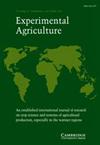Optimizing the clipping frequency and nitrogen topdressing in a dual-purpose oat used for fodder and cover cropping
IF 1.9
4区 农林科学
Q1 Agricultural and Biological Sciences
引用次数: 0
Abstract
Summary Management strategies such as nitrogen (N) topdressing and clipping can be used to optimize a cover crop for the dual purpose of soil cover and forage. The present study tested oat (Avena sativa) for a holistic provision of soil cover and forage under various levels of clipping frequency and N topdressing. Effects on root and above-ground biomass, acid detergent fiber, neutral detergent fiber, and crude protein (CP) were evaluated. Clipping frequency had four levels, namely clipped only at termination (C1), clipped at 28 days after emergence (DAE) and termination (C2), clipped at 28, 42 DAE, and termination (C3), and clipped at 28, 42, 56 DAE, and termination (C4). Nitrogen topdressing had two levels, namely with (N1) and without (N0) the recommended N topdressing. Increasing clipping frequency reduced the root and aerial biomass and did not affect the forage quality harvested before termination. However, N topdressing increased biomass and CP content across the clipping frequencies. Results suggest clipping thrice combined with N topdressing (C4 + N1) provides the best option to satisfy both soil cover and livestock demands. The treatment (C4 + N1) gave > 2 t ha−1 of biomass during the growing period and 6 t ha−1 at termination which can be used for livestock forage and soil cover, respectively. Clipping thrice without N topdressing (C4 + N0) was the best option for resource-constrained farmers.饲覆两用燕麦刈割频率及氮肥追肥优化
氮肥追肥和修剪等管理策略可用于优化覆盖作物,以实现土壤覆盖和饲料的双重目的。本研究对不同刈割频率和氮素追肥水平下燕麦(Avena sativa)整体提供土壤覆盖物和饲料进行了试验。评价其对根系和地上部生物量、酸性洗涤纤维、中性洗涤纤维和粗蛋白质(CP)的影响。剪断频率分为4个级别,即仅在终止时剪断(C1)、在出蛹后28天剪断(DAE)并终止(C2)、在28、42天剪断并终止(C3)、在28、42、56天剪断并终止(C4)。施氮量分为施(N1)和不施(N0)两个水平。刈割频率的增加减少了根生物量和地上生物量,但不影响刈割前收获的牧草质量。然而,在各个刈割频率上,追肥均增加了生物量和CP含量。结果表明,3次修剪配合C4 + N1追肥是满足土壤覆盖和牲畜需求的最佳选择。处理(C4 + N1)在生育期和终止期分别提供了2 t ha - 1和6 t ha - 1的生物量,可分别用于家畜饲料和土壤覆盖。对于资源受限的农户,3次刈割不施氮(C4 + N0)是最佳选择。
本文章由计算机程序翻译,如有差异,请以英文原文为准。
求助全文
约1分钟内获得全文
求助全文
来源期刊

Experimental Agriculture
农林科学-农艺学
CiteScore
2.50
自引率
6.20%
发文量
29
审稿时长
24 months
期刊介绍:
With a focus on the tropical and sub-tropical regions of the world, Experimental Agriculture publishes the results of original research on field, plantation and herbage crops grown for food or feed, or for industrial purposes, and on farming systems, including livestock and people. It reports experimental work designed to explain how crops respond to the environment in biological and physical terms, and on the social and economic issues that may influence the uptake of the results of research by policy makers and farmers, including the role of institutions and partnerships in delivering impact. The journal also publishes accounts and critical discussions of new quantitative and qualitative methods in agricultural and ecosystems research, and of contemporary issues arising in countries where agricultural production needs to develop rapidly. There is a regular book review section and occasional, often invited, reviews of research.
 求助内容:
求助内容: 应助结果提醒方式:
应助结果提醒方式:


